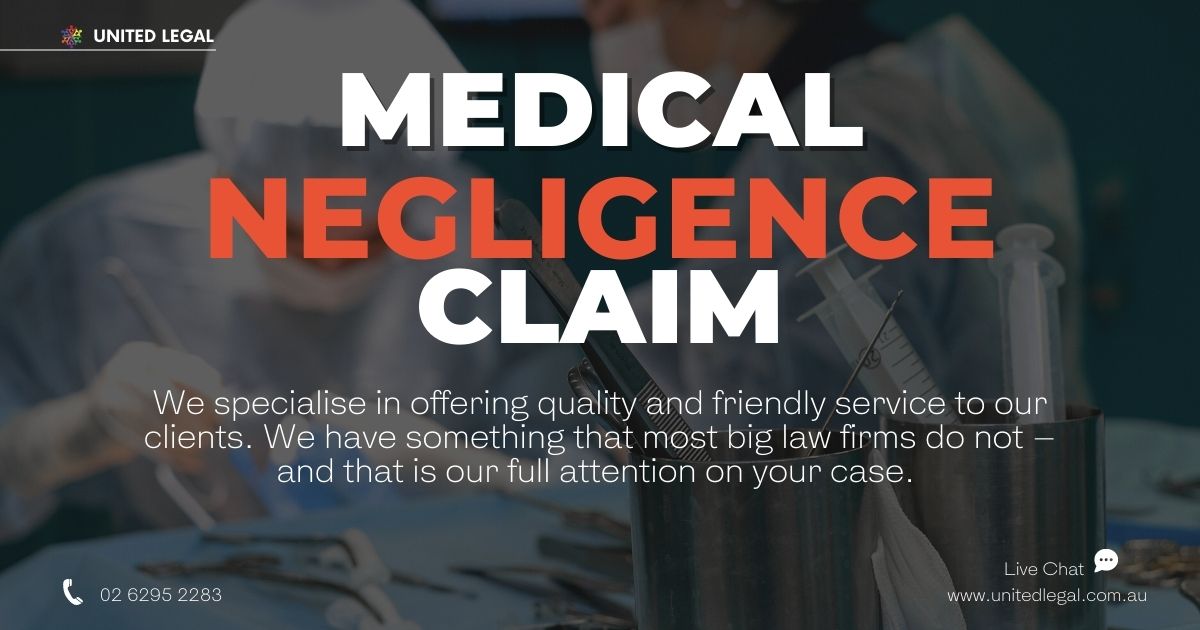Australian law holds the relationship between medical professionals and their patients to a higher standard of care. It implies that the doctor owes a duty of care to the patient, and any breach of this responsibility may result in medical negligence. Moreover, if this causes any real damage, such as physical or financial injuries, the patient may be able to demand compensation.
Much like making a successful public liability claim, medical negligence claims involve certain criteria for compensation. Primarily, you must prove that a doctor-client relationship existed, which would imply that it involved a duty of care. Moreover, you must also prove that there was either a breach in the duty of care or a failure to perform the medically necessary actions for your health. Finally, you must also prove that the breach of responsibility resulted in physical and/or emotional injury.
However, it is important to note that while these steps have been simplified for awareness, they may involve legal complications depending on the case we’re dealing with. Due to unique circumstances and other associated factors, each case will vary, and a medical negligence lawyer can help navigate any complexities.
Proving that there was a breach in the duty of care can be difficult since the burden of proof is on the patient. Moreover, if your doctor’s treatment and actions are ‘widely accepted in Australia by peer professional opinion as competent professional practice’, then there is no liability for medical negligence. On the other hand, if your medical professional failed to warn you of certain significant risks, the Court will qualify your case as medical negligence. This sort of case usually applies to elective surgeries where patients must be aware of material risks.
Proving Causation in Medical Negligence Cases
Even if you prove negligence, you must still successfully show causation. It implies that the patient must prove that their injuries are a direct result of the doctor’s action or inaction. However, it may not be as easy as it seems.
Many healthcare practitioners, hospitals, and insurers will often state that your injury is a direct result of an underlying illness or medical condition instead. Hence, in situations like these, it can be tricky to prove that you would’ve faced a better outcome if the doctor had acted more responsibly.
In situations like these, it may be difficult to find the right and adequate evidence to prove your case. However, a medical negligence lawyer can help pull out medical records, seek professional medical advice, and find other relevant documents to prove your claim.
In addition, you will need to prove that you suffered at least 15% permanent impairment. Due to medical negligence. However, you must prove this within three years of you noticing the issue.
Generally, a successful medical claim must meet the following two criteria –
- Determining the circumstances – If the act of negligence or omission didn’t occur, it would result in no harm or injury.
- Scope of liability – There is a breach of the duty of care, but is the medical professional legally liable for the damage?
Now, while this may be tricky, the scope of liability involves looking at the degree of connection between the breach and injury and will also include an evaluation of policy concerns.
Also Read: How The Pandemic Has Changed Medical Negligence Claims
Different Types of Medical Negligence Claims
Misdiagnosis & Delayed Diagnosis
The first step will involve admittance to a hospital, medical clinic, emergency room, dental office, or any other professional medical establishment. At this point, the duty of care requires the medical professional to deliver the highest standard of care, ask for any relevant medical history, and diagnose the patient’s symptoms and condition correctly before moving on to treatment.
However, in some cases, the medical professional can cause an error in diagnosis. While it may vary from case to case, many individuals often suffer from life-threatening diseases and/or injuries due to misdiagnosis and mistreatment.
To provide a clearer perspective, some examples include failure to diagnose cancer, misdiagnosis of symptoms of impending heart attack or stroke, failure to recognise pulmonary embolism, meningitis or appendicitis, etc. Such cases can result in severe physical injuries that may require additional treatment. However, if the medical professional diagnosed the patient correctly on the initial visit, a correct and timely treatment could’ve avoided further injuries.
Many people are unaware, but a delayed diagnosis can be a form of medical negligence if another doctor under the same circumstances with the same patient would’ve reasonably and timely diagnosed the same condition. Delayed diagnosis can lead to an undue injury to the patient if the illness progresses without treatment.
The usual reasons behind such cases is fatigue or other commitments that diminish a doctor’s capacity to properly administer medical treatment. However, the hospital or clinic may be liable for damages resulting from the delayed diagnosis and treatment.
Surgical Errors
Unfortunately, these cases are very common. Medical negligence during a surgical procedure can often result in further surgeries, infection and sepsis, immune system failure, internal organ damage, and even death. Understandably, surgical procedures require an enormous level of skill and alertness because even the slightest mistakes can ultimately have profound effects on the patient.
Many health professionals may attempt to cover this up in Court by disguising it as risks from the surgery. However, surgeons need to discuss such risks with the patient before the surgery. If the surgical error wasn’t a part of those risks, it makes a stronger case for the patient.
In addition, patients can prove many surgical errors with the help of other medical professionals. It is important to note that most surgical errors are not a part of the routine surgery risks. It may occur in a variety of forms ranging from unintentional lacerations of an internal organ, wrong site surgery, uncontrolled blood loss, and perforation of an organ to leaving foreign objects in the patient’s body.
One of the most dangerous risks in any surgical procedure is cutting, lacerating, or perforating an artery, vessel, or organ. There are various ways a surgeon can make a potentially fatal error like such during an operation. In many cases, it can eventually lead to severe infection and sepsis, which can result in septic shock and death.
Moreover, performing surgery at the wrong site also counts as a surgical error. It is usually the result of a miscommunication or error in hospital records, which can lead to a surgeon’s operation on the wrong site. Hence, they come under the medical negligence claim.
Again, such errors can lead to irreversible damage or even death.
Unnecessary Surgeries and Complications in Anesthesia
Many times, doctors will recommend and perform unnecessary surgeries without properly considering other options or risks. While surgery is sometimes a better option than conventional treatments, doctors must explore every treatment option available to make an informed decision.
Many of the common unnecessary surgical procedures include pacemaker implant, cesarean surgery, coronary bypass surgery, and hysterectomy. While, in many cases, surgeries are necessary to save lives, sometimes the patient’s condition doesn’t warrant such dramatic and invasive procedures.
Moving on to anesthesia, it is inherently a risky part of any major medical operation. It requires a specialist – an anesthesiologist – to administer and monitor the effect on the patient throughout the surgical procedure.
However, in all cases, the anesthesiologist must review the patient’s medical records, history, medications, allergies, and time requirements for the operation. If they don’t take care of these factors carefully, it can result in fatal injuries or even death.
Childbirth Trauma & Labor Malpractice
Childbirth, in itself, can be a difficult event for the newborn child and even worse in cases of medical negligence. Many such irresponsible cases include failure to perform a C-section, mishandling difficult births, complications with induced labour, misdiagnosis of newborn’s medical conditions, etc.
A cesarean section or c-section is often a requirement to preserve the health of the many and the mother in cases of fetal distress. Generally, the baby will show signs of fetal distress such as low blood pressure, lack of oxygen or reduced heartbeat. In such cases, a c-section becomes a medical necessity to prevent any injuries or death.
However, if the medical staff fails to perform the c-section in time, delaying the procedures in hopes of normal delivery, the decision may result in permanent brain damage to the baby.
Talk to a United Legal Medical Negligence Lawyer Today
Undoubtedly, medical negligence law can seem like a complicated area. Moreover, the incident in itself can be physically and emotionally traumatic, causing financial strain on the client. In many medical negligence cases, it can impact your day-to-day life and employment, which can result in lost wages and other financial liabilities.
Every day, United Legal lawyers help Australians receive the compensation they deserve. In confidence of our experience, and the concern for our clients to make sure financial limitations aren’t a hurdle in justice, we offer a no-win-no-fee policy.
Take the first step towards justice and compensation. Contact one of our lawyers today to arrange a detailed consultation.
United Legal
Medical Negligence Lawyers Canberra
For our legal support services Contact us at (02) 6295 2283
Visit us at









